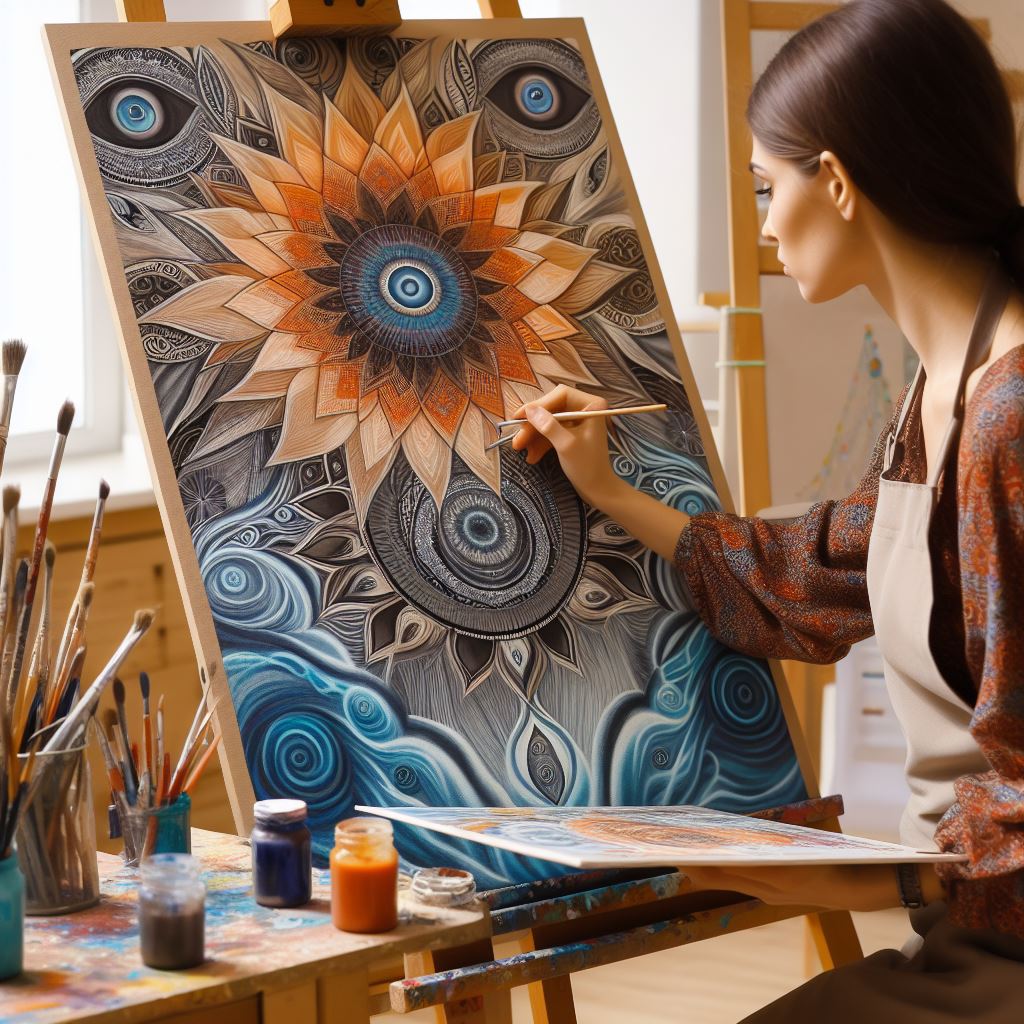Introduction
Definition of art therapy
Art therapy is a therapeutic practice that utilizes creative outlets, such as painting, drawing, and sculpture, to improve mental health.
In Canada, where the prevalence of mental health issues is increasing, it has become crucial to prioritize mental wellness.
With its effectiveness in promoting self-expression, relaxation, and emotional healing, art therapy has gained momentum as a growing trend in addressing mental wellness in the country.
Art therapy allows individuals to express their thoughts, emotions, and experiences through various artistic mediums.
Through the creative process, individuals can gain insight, explore their feelings, and find alternative ways to cope with stressors.
This therapeutic approach offers a safe space for self-reflection and personal growth.
Importance of mental wellness in Canada
In Canada, mental health issues affect a significant portion of the population.
The pressures of modern life, economic challenges, and societal expectations all contribute to the growing need for mental wellness practices.
Art therapy has gained recognition for its ability to enhance well-being, support self-care, and provide a non-verbal means of communication.
The growing trend of art therapy
The growing trend of art therapy in Canada is evident in the increasing number of art therapists, specialized programs, and community initiatives.
Art therapy is being recognized as a valuable component of comprehensive mental health care, integrating with traditional forms of therapy and medication.
It offers a unique and effective approach that empowers individuals to explore their emotions, improve their self-esteem, and cultivate a sense of purpose.
Basically, art therapy is a growing trend in Canadian wellness due to its ability to promote self-expression and emotional healing.
In a country where mental wellness is crucial, art therapy offers a non-verbal means of communication and self-reflection.
It has become an integral part of comprehensive mental health care, empowering individuals to overcome challenges and improve their overall well-being.
The Benefits of Art Therapy
Art therapy is not just a growing trend; it is a powerful tool that offers numerous benefits to individuals seeking wellness.
By engaging in creative processes under the guidance of trained professionals, individuals can enhance their emotional well-being, boost self-esteem and self-expression, reduce stress and anxiety, facilitate personal growth and insight, and ultimately improve their overall mental health.
Enhancing emotional well-being
Art therapy provides a safe and supportive environment for individuals to express themselves through art.
The creative process allows emotions to be communicated, explored, and understood in a non-verbal manner.
Through various art mediums such as painting, sculpting, and drawing, individuals can visually convey their emotions, thoughts, and experiences.
Boosting self-esteem and self-expression
Engaging in artistic activities within a therapeutic context can boost an individual’s self-esteem and self-expression.
Art therapy encourages individuals to explore their inner selves, helping them gain confidence in their unique abilities and perspectives.
By creating art, individuals can communicate their identity, values, and desires in a tangible and meaningful way.
Reducing stress and anxiety
Creating art in a therapeutic environment also has the potential to reduce stress and anxiety.
The act of focusing on artistic tasks can promote relaxation and mindfulness, allowing individuals to release tension and relieve symptoms of stress.
Unlock Your Career Potential
Visualize a clear path to success with our tailored Career Consulting service. Personalized insights in just 1-3 days.
Get StartedThrough art therapy, individuals can experience a sense of calm and improve their overall emotional well-being.
Facilitating personal growth and insight
Art therapy is a powerful tool for facilitating personal growth and insight.
By engaging in the creative process, individuals can gain deeper self-awareness and develop a better understanding of themselves.
The act of creating art can uncover hidden emotions, thoughts, and beliefs, enabling individuals to explore their inner world and make meaningful connections.
Improving overall mental health
Studies have shown that art therapy has a positive impact on overall mental health.
Regular engagement in art therapy can help alleviate symptoms of depression, anxiety, and other mental health disorders.
Artistic expression has a unique way of bringing joy, fulfillment, and a sense of purpose to individuals, contributing to their overall well-being.
Essentially, this therapy offers a wide range of benefits to individuals seeking wellness.
It enhances emotional well-being, boosts self-esteem and self-expression, reduces stress and anxiety, facilitates personal growth and insight, and improves overall mental health.
Through the creative process, individuals can find healing, self-discovery, and a deeper connection with themselves.
Read: Emerging Art Trends in Canada for 2024-2024
Art Therapy Approaches
Art therapy approaches offer unique ways to explore emotions, process trauma, and promote overall well-being.
Let’s dive deeper into each approach:
Expressive arts therapy
This approach recognizes that each individual has their own preferred form of artistic expression.
Whether it’s painting, sculpting, or collage, the focus is on self-expression and exploration.
Through the use of various art mediums, individuals can tap into their emotions, release pent-up feelings, and gain a deeper understanding of themselves.
Visual art therapy
Drawing, painting, and photography are powerful tools for self-reflection and healing.
Through visual art, individuals can externalize their thoughts and feelings, making them more tangible and easier to explore.
This approach allows individuals to discover patterns, symbols, and themes in their artwork, providing insights into their unconscious mind.
Music therapy
Music has the ability to evoke emotions and create a sense of connection.
In music therapy, individuals can engage in activities like playing instruments, singing, or listening to music tailored to their needs.
Music can facilitate emotional expression, help regulate mood, and provide a safe space for self-exploration and healing.
Dance/movement therapy
Movement is a universal language that allows individuals to express themselves physically.
Through dance and movement, individuals can release tension and access emotions that may be difficult to articulate verbally.
This approach integrates body awareness, rhythm, and creative expression to promote self-discovery and emotional well-being.
Drama therapy
Acting out different roles and scenarios helps individuals gain new perspectives and explore alternative narratives.
Drama therapy creates a safe space for individuals to express emotions, resolve conflicts, and gain deeper insights into their own experiences.
Using improvisation, role-playing, and storytelling, this approach fosters creativity, self-awareness, and personal growth.
These art therapy approaches can be used individually or in combination, depending on the needs and preferences of each individual.
The therapeutic process involves a skilled art therapist who guides and supports individuals in their creative journey.
In general, this therapy approaches like expressive arts therapy, visual art therapy, music therapy, dance/movement therapy, and drama therapy offer powerful tools for self-expression, healing, and personal growth.
By engaging in creative activities, individuals can tap into their inner world, process emotions, and gain new insights into themselves.
The growing trend of this therapy in Canada reflects the recognition of its effectiveness in supporting wellness and mental health.
Read: Indigenous Art in Canada: Voices and Visions
Art Therapy in Canada
Development and history
- Art therapy has been practiced in Canada for several decades.
- Started gaining recognition in the 1960s through pioneers in the field.
- Initially used in psychiatric hospitals but has now expanded to various settings.
- Helped individuals express themselves and improve their mental well-being.
Increasing recognition and availability
- Art therapy has gained significant recognition as a valuable therapeutic approach.
- Now widely available in hospitals, clinics, schools, and community centers.
- Part of the growing trend toward holistic approaches to wellness.
- Increasingly incorporated into treatment plans for mental health and well-being.
Accredited art therapy programs and organizations
- Various institutions in Canada offer accredited art therapy programs.
- Canadian Art Therapy Association (CATA) is the main professional organization.
- CATA sets standards for education, ethics, and professional practice.
- Membership in CATA provides credibility and networking opportunities for art therapists.
Statistics on the rise of art therapy in Canada
- The demand for this therapy in Canada has been steadily increasing over the years.
- A survey conducted by CATA reported a 40% growth in this therapy services.
- More than 60% of art therapists in Canada reported an increase in client referrals.
- This therapy is now recognized as a vital component of mental healthcare in Canada.
Development and history
Art therapy is an established and growing trend in Canadian wellness.
With its development and history dating back several decades, the practice has gained recognition and availability across various settings.
Initially used in psychiatric hospitals, it now serves individuals in hospitals, clinics, schools, and community centers.
Increasing recognition and availability
The increasing recognition of this therapy aligns with the holistic approach to wellness.
As people become more aware of the importance of mental well-being, this therapy has become a valuable therapeutic approach.
Incorporating this therapy into treatment plans for mental health issues and overall well-being has become more commonplace.
Accredited art therapy programs and organizations
In Canada, there are accredited art therapy programs offered by various institutions.
These programs ensure that therapists receive appropriate training and education to provide high-quality services.
The Canadian Art Therapy Association (CATA) is the main professional organization that sets standards for education, ethics, and professional practice.
Art therapists benefit from being a member of CATA as it provides credibility and networking opportunities.
The rise of this therapy in Canada is supported by statistics.
A survey conducted by CATA revealed a 40% growth in this therapy services, indicating an increasing demand for these services.
Moreover, more than 60% of art therapists reported an increase in client referrals, highlighting the recognition and trust placed in this therapeutic approach.
Art therapy has become an integral part of mental healthcare in Canada, recognized for its effectiveness and positive impact on individuals’ well-being.
In essence, art therapy in Canada has a rich developmental history and is experiencing increasing recognition and availability.
Accredited programs and professional organizations contribute to the growth and credibility of this therapeutic approach.
The rise of art therapy is supported by statistical evidence, showing its importance in the field of mental healthcare.
As the trend continues to grow, more individuals in Canada can benefit from the healing power of art therapy.
Read: Balancing Art and Business: Tips for Canadian Artists

Success Stories and Case Studies
Personal experiences from art therapy participants
- Art therapy has provided a safe space for individuals to express their emotions and experiences through various art forms.
- Participants have reported feeling a sense of relief and healing after engaging in art therapy sessions.
- One participant shared how art therapy helped them process childhood trauma and improve their mental well-being.
- Another individual expressed how art therapy allowed them to explore their creativity and regain a sense of self-esteem.
- Many art therapy participants have described feeling more connected to their emotions and gaining a better understanding of themselves.
- Participants often express gratitude for the opportunity to engage in art therapy and appreciate the nonjudgmental environment it provides.
- Several individuals have credited art therapy for helping them cope with anxiety, depression, and other mental health challenges.
- Art therapy participants often form a supportive community where they can share their art, stories, and struggles with others.
- Many people have reported that participating in art therapy has improved their ability to communicate and express themselves.
- Multiple individuals have stated that art therapy has become an essential part of their self-care routine and overall wellness.
Impact of art therapy on individuals’ well-being
- Art therapy has been shown to reduce stress levels and promote relaxation in participants.
- Engaging in art therapy activities can improve mood and enhance positive emotions.
- This therapy has been found to increase self-awareness and foster personal growth and development.
- Participants often experience a boost in self-confidence and a greater sense of self-acceptance through this therapy.
- This therapy can provide a healthy outlet for emotional expression, leading to a reduction in emotional distress.
- Many individuals find that this therapy helps them develop coping skills and build resilience.
- The creative process involved in this therapy can enhance problem-solving abilities and promote cognitive skills.
- This therapy has been proven effective in reducing symptoms of anxiety and depression in many individuals.
- Participants often experience an improved sense of well-being and an increased overall quality of life.
- Art therapy can empower individuals to take control of their mental health and guide their own healing journey.
Case studies showcasing the effectiveness of art therapy
- Case study 1: A 35-year-old woman with a history of trauma and depression showed significant improvement in her symptoms after engaging in art therapy for six months.
- Case study 2: A teenage boy struggling with anger management found this therapy to be a transformative experience, helping him develop healthier coping mechanisms.
- Case study 3: An elderly individual suffering from dementia experienced improved memory and cognitive function through regular participation in this therapy.
- Case study 4: A young adult with social anxiety disorder reported a reduction in anxiety symptoms and an improvement in social skills following this therapy sessions.
- Case study 5: A cancer survivor found this therapy to be a powerful tool in processing trauma and finding hope and motivation during the recovery process.
- Case study 6: An individual struggling with body image issues and low self-esteem gained confidence and self-acceptance through this therapy practices.
- Case study 7: A child with autism spectrum disorder showed enhanced communication and social skills after engaging in this therapy sessions.
- Case study 8: A military veteran with post-traumatic stress disorder (PTSD) found art therapy to be helpful in managing symptoms and promoting emotional healing.
- Case study 9: A person struggling with addiction used art therapy as a means to explore and express underlying emotions, supporting their recovery journey.
- Case study 10: An individual experiencing chronic pain found art therapy to be a valuable tool in reducing pain perception and improving overall well-being.
Read: The Role of Art Collectives in Canada’s Art Scene
Integrating Art Therapy in Wellness Programs
Integrating art therapy into wellness programs is becoming increasingly popular in Canada.
Collaboration with mental health professionals
Collaborating with mental health professionals is essential for a successful art therapy program.
By working together, art therapists and mental health professionals can create a comprehensive approach to healing.
Incorporation of art therapy in hospitals and healthcare settings
This therapy can be incorporated into hospitals and healthcare settings to enhance patient well-being.
Artistic expression can provide a creative outlet for patients, leading to improved mental and physical health.
In hospitals, this therapy can be used as a complementary treatment alongside traditional medical interventions.
Art therapy in schools and educational institutions
Educational institutions can greatly benefit from incorporating this therapy into their curriculum.
This therapy in schools can help students express themselves, reduce stress, and enhance their emotional well-being.
By engaging in creative activities, students can improve their problem-solving skills and boost their self-confidence.
Incorporating art therapy into schools can also foster a sense of community and inclusion.
Community-based art therapy initiatives
Community-based art therapy initiatives are another important avenue for promoting wellness in Canada.
These initiatives can target specific populations, such as at-risk youth or individuals experiencing trauma.
Art therapists can work with community organizations to develop art therapy programs that address specific needs.
By engaging with art in a therapeutic context, individuals can process their emotions and find healing.
These community-based initiatives can help reduce social isolation and improve overall mental health.
Overall, integrating art therapy into wellness programs offers numerous benefits for individuals and communities.
Through collaboration with mental health professionals, art therapy can provide a holistic approach to healing.
Incorporating this into hospitals, schools, and community settings expands access to this valuable form of therapy.
This has the power to inspire creativity, improve mental health, and enhance overall well-being.
Challenges and Considerations
Limited insurance coverage for art therapy
- Art therapy is often not covered by insurance, making it inaccessible for many Canadians.
- This lack of coverage limits the number of individuals who can afford to participate in the therapy.
- Healthcare providers and policymakers need to recognize the value of art therapy and consider including it in insurance coverage.
Lack of standardized regulations and qualifications
- Currently, there are no standardized regulations or qualifications for art therapists in Canada.
- This lack of regulation can lead to inconsistency and varying levels of competence within the field.
- Establishing standardized regulations and qualifications would ensure the safety and effectiveness of art therapy practices.
Ensuring cultural sensitivity and inclusivity in art therapy practices
- Art therapy needs to be culturally sensitive and inclusive to accommodate the diverse population in Canada.
- Therapists should be knowledgeable and respectful of different cultural practices and beliefs.
- Intentional efforts must be made to create a safe and inclusive space for individuals from all cultural backgrounds.
- Art materials, themes, and techniques used in therapy should be selected with the consideration of cultural appropriateness.
In a nutshell, while art therapy is a growing trend in Canadian wellness, there are several challenges and considerations that need to be addressed.
Limited insurance coverage for art therapy prevents many individuals from accessing this beneficial form of therapy.
Additionally, the lack of standardized regulations and qualifications within the field can lead to inconsistent practices and varying levels of competence.
Lastly, ensuring cultural sensitivity and inclusivity is crucial in art therapy to accommodate the diverse population in Canada.
By recognizing and addressing these challenges, they can continue to grow and contribute to the overall well-being of Canadians.
Delve into the Subject: Journalism Ethics: A Canadian Perspective
Conclusion
Art therapy allows individuals to express themselves creatively, providing a safe space for emotional exploration and healing.
Through the use of various artistic mediums, individuals can explore their thoughts, feelings, and experiences.
This creative process helps individuals gain insights, improve self-esteem, and empower personal growth.
Moreover, art therapy has been proven effective in treating a wide range of mental health conditions.
It helps individuals cope with anxiety, depression, trauma, and even chronic pain.
By engaging in art therapy, people can develop new coping mechanisms and enhance their overall well-being.
In Canada, the demand for art therapy has been steadily increasing in various healthcare settings, schools, and community programs.
Art therapists are increasingly recognized as integral members of healthcare teams, working alongside psychologists and counselors.
As we move forward, it is essential to encourage individuals to explore art therapy as a therapeutic option.
By raising awareness and promoting accessibility, we can ensure that more people can benefit from this growing trend.
So, whether you are struggling with mental health concerns or simply looking to enhance your well-being, give art therapy a try.
Unleash your creativity, discover your inner artist, and experience the transformative power of art therapy.
You never know, art therapy might just become an essential part of your personal wellness toolkit.




